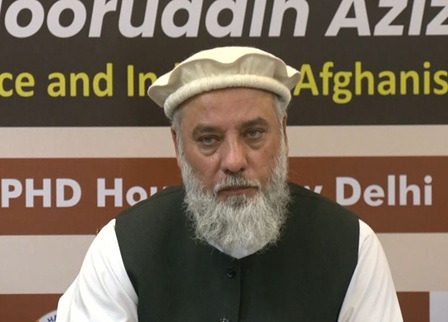
By Mirwais Jalalzai
Landslides, heavy rains, flooding, food shortages, and stagnating economic growth are just some of the devastating impacts South Asia may experience due to advancing climate change, according to the United Nations.
A UN report which is recently published about climate change and it is impacts on South Asia and global south said, after wars and conflicts that is climate change which forced people in south Asia to migrate from their home countries to other part of the continent or even the world.
Though written in an academic tone, the report’s conclusions are stark and sobering. Even under the most modest assumptions about emissions growth, the future effects of climate change will touch every corner of the globe, with potentially profound consequences for international peace and prosperity.
 According to the recent investigations by climate change activists and organizations which works on this issue, these effects will be felt worldwide, but they will be especially keen in South Asia – defined as Afghanistan, Bangladesh, Bhutan, India, Maldives, Nepal, Pakistan, and Sri Lanka.
According to the recent investigations by climate change activists and organizations which works on this issue, these effects will be felt worldwide, but they will be especially keen in South Asia – defined as Afghanistan, Bangladesh, Bhutan, India, Maldives, Nepal, Pakistan, and Sri Lanka.
The climate change effects we are already seeing — ranks Asia and over all the global south as the biggest victim of natural disasters in recent years, accounting for nearly 30 percent of the global economic loss ascribed to natural disasters, CSE ( Center of Since and environment) of India said.
Global south’s vulnerability to these and future disasters is profound, principally for reasons of population and poverty. The majority of South Asian countries are low- or lower-middle income countries that already struggle to support the daily needs of their growing populations. Because poorer households dedicate more of their budgets to food, they are the most sensitive to weather-related shocks that can make daily staples unaffordable.
Afghanistan a country with agriculture economy ( 80 % people busy with agriculture) is an example in South Asia which is badly affected by climate change and the people are become poor and poorer in recent years. The formers lost their harvests because of unexpected rains and the floods destroyed agricultural lands in deferent part of the country.
Rising sea level and reduced production in agriculture pose the biggest threats. Kolkata, Mumbai, and Dhaka, whose greater urban areas are home to over 46 million people and rising, face the greatest risk of flood-related damage over the next century.
Low-lying Bangladesh is vulnerable to flooding and cyclones in the Indian Ocean, which scientific literature suggests will grow more intense in coming decades. In 1991, a 20-foot storm surge that followed a cyclone killed nearly 140,000 people in Bangladesh and left up to 10 million homeless.
The destruction that flooding could wreak in South Asia’s low-lying and urban areas is cruelly complemented by the effects that drought and changes in seasonal rainfall will have on agriculture. Extreme heat is already disrupting the growing season for regions in Pakistan, India, and Bangladesh. Wheat production in the Indian portion of the Indo-Gangetic Plains, a fertile area that also encompasses parts of Pakistan and Bangladesh, may decrease by up to 50 percent by 2100, harming the hundreds of millions of people who rely on it for sustenance.
To insulate themselves from these potential threats, South Asian nations will have to invest heavily in both mitigation and adaptation. Two structural factors hold back these efforts: the lack of consensus around international funding and the lack of regional cooperation.
The controversy surrounding the release of the IPCC report demonstrates some of the challenges. Rich countries, including the United States” asked that an estimate of the amount of money necessary for adaptation measures ($100 billion a year) be removed from the report’s summary for policymakers.
Developed countries apparently felt that inclusion of the figure might reinforce arguments that they would need to increase official development assistance to poorer nations – a political non-starter for many in advanced economies. For their part, developing countries insist they need concrete promises from industrialized nations about the level of aid forthcoming, as well as a timeframe for disbursement.
The United States highlights its efforts at cooperating with developing nations as a cornerstone of its strategy for addressing climate change. Unfortunately, these relationships have run into problems on the ground. The United States and India have established joint cooperation on clean energy development, for example, but are also entangled in disputes at the WTO over domestic subsidies for solar manufacturers.
And while India is aggressively expanding its installed solar capacity — including what will be the largest solar plant in the world in Rajasthan — Pakistan and Bangladesh possess almost no non-hydroelectric renewable energy. As renewable energy expands in the United States and the European Union, the opportunity for sharing best practices is too valuable not to pursue.
One solution would be to expand the U.S.-India Energy Dialogue to include all nations in the region and invite more involvement and investment from American private enterprise. This collaboration could satisfy both the developing world’s need for support, and the developed world’s desire to promote their own renewable industries, especially farther up the production value chain.
For example if we call the CO2 which is producing by developed countries like China, USA, Germany, Russia..etc as a CO2 cake, so this is not the responsibility of poor and 3world countries to take and eat the big piece of cake because as much as you produce you should eat , CSE India director Sunita Narain said.
The regional security framework is another impediment to the adoption of sensible mitigation and adaptation strategy. Not only does the bilateral Indian-Pakistani relationship suffer from the tangled legacy of partition and subsequent wars, Indian-Bangladeshi relations are also complicated, especially over the question of migration.
The United States intelligence community, and in particular, the Department of Defense, are worried that climate change may incite armed conflict in the future.
The CSE calls for “enhanced regional cooperation,” without suggesting in detail what may be done under the present circumstances.
But given the immediate concerns that South Asian countries are facing, it will be some time before they can realistically pursue these ambitious efforts. Bangladesh is embroiled in post-election turmoil; Pakistan is facing a crisis at the hands of internal militancy; India, after its border clashes with Pakistan will try to restore robust economic growth.
Greater economic integration could be another solution to South Asia’s coming resource shortages. World Bank research on climate change in the Philippines, for example, demonstrates that rural villagers recover from weather-related resource shocks more easily the closer they live to markets and critical transportation infrastructure. The more connections to the outside world, the easier it is to obtain less expensive substitute goods from unaffected regions.








